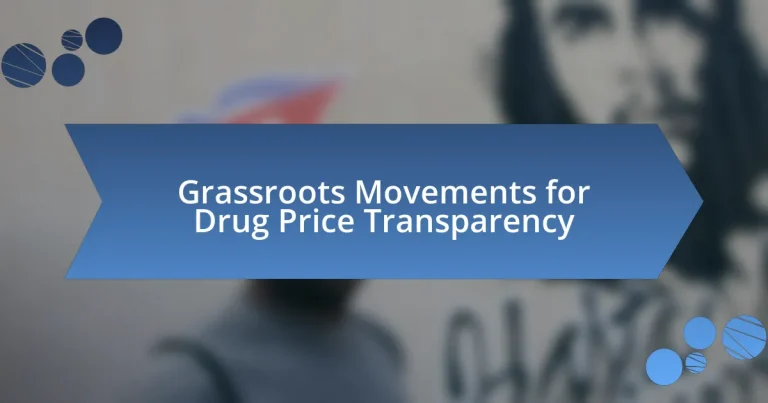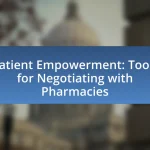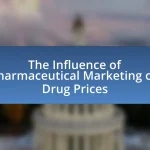Grassroots movements for drug price transparency are collective initiatives aimed at advocating for clearer information on prescription medication costs, empowering consumers to make informed healthcare decisions. These movements influence drug pricing policies through public support and legislative advocacy, employing strategies such as social media campaigns and community organizing to raise awareness. The article explores the importance of drug price transparency, its impact on public health, and the challenges faced by grassroots movements, including political and economic barriers. Additionally, it highlights successful examples of advocacy, the role of social media, and best practices for effective collaboration among stakeholders in the pursuit of equitable drug pricing.
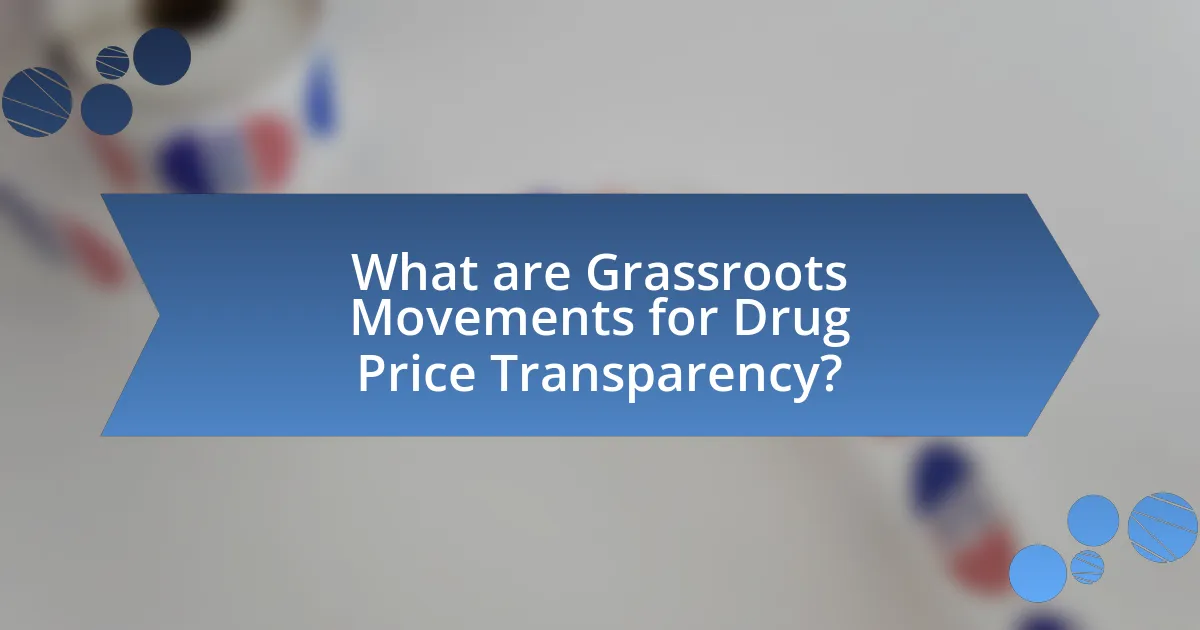
What are Grassroots Movements for Drug Price Transparency?
Grassroots movements for drug price transparency are collective efforts by individuals and organizations advocating for clearer information regarding the costs of prescription medications. These movements aim to empower consumers by demanding that pharmaceutical companies disclose pricing structures, enabling patients to make informed decisions about their healthcare. For instance, initiatives like the “Patients for Affordable Drugs” campaign have successfully lobbied for legislative changes that promote transparency in drug pricing, highlighting the significant impact of grassroots activism on public policy.
How do grassroots movements influence drug pricing policies?
Grassroots movements influence drug pricing policies by mobilizing public support and advocating for legislative changes that promote transparency and affordability. These movements often raise awareness about high drug prices, leading to increased pressure on policymakers to implement reforms. For example, the “Patients for Affordable Drugs” coalition has successfully lobbied for initiatives that require pharmaceutical companies to disclose pricing information, which has resulted in legislative proposals aimed at capping drug prices in several states. Such movements leverage social media and community organizing to amplify their message, thereby influencing public opinion and encouraging lawmakers to prioritize drug pricing reforms.
What strategies do these movements employ to raise awareness?
Grassroots movements for drug price transparency employ strategies such as social media campaigns, community organizing, and public demonstrations to raise awareness. Social media campaigns leverage platforms like Twitter and Facebook to disseminate information rapidly, engage supporters, and mobilize action, evidenced by the success of campaigns like #PharmaBro and #FairDrugPrices. Community organizing involves building local coalitions that educate citizens about drug pricing issues, exemplified by initiatives from organizations like Patients for Affordable Drugs, which provide resources and training for grassroots activists. Public demonstrations, such as protests and rallies, draw media attention and public interest, as seen in events organized by groups like the Alliance for Patient Access, which highlight the impact of high drug prices on patients. These strategies collectively enhance visibility and foster public discourse around the need for drug price transparency.
How do grassroots movements collaborate with other organizations?
Grassroots movements collaborate with other organizations through strategic partnerships, resource sharing, and coordinated advocacy efforts. These collaborations often involve aligning goals with established organizations, such as non-profits or advocacy groups, to amplify their message and reach a broader audience. For instance, grassroots movements focused on drug price transparency may partner with healthcare organizations to leverage their expertise and networks, thereby enhancing their impact on policy change. This approach is supported by evidence from various case studies, such as the collaboration between grassroots groups and larger health advocacy organizations that successfully influenced legislation on drug pricing in several states.
Why is drug price transparency important?
Drug price transparency is important because it empowers consumers to make informed decisions about their healthcare and fosters competition among pharmaceutical companies. When patients have access to clear pricing information, they can compare costs and choose more affordable options, which can lead to lower overall healthcare expenses. A study by the Health Affairs journal found that price transparency initiatives can reduce drug prices by up to 10% in some markets, demonstrating the potential for significant savings. Additionally, transparency can hold pharmaceutical companies accountable for pricing practices, ultimately leading to fairer pricing structures and improved access to necessary medications for all patients.
What impact does drug pricing have on public health?
Drug pricing significantly impacts public health by influencing access to essential medications. High drug prices can lead to reduced medication adherence, as patients may forgo necessary treatments due to cost, resulting in worsened health outcomes. For instance, a study published in the Journal of the American Medical Association found that nearly 25% of Americans reported not filling a prescription due to high costs, which can exacerbate chronic conditions and increase healthcare costs in the long run. Additionally, disparities in drug pricing can disproportionately affect low-income populations, leading to inequities in health access and outcomes.
How does transparency affect consumer trust in the pharmaceutical industry?
Transparency significantly enhances consumer trust in the pharmaceutical industry by providing clear information about drug pricing, safety, and efficacy. When pharmaceutical companies openly share data regarding clinical trials, pricing structures, and potential side effects, consumers feel more informed and empowered to make decisions about their healthcare. A study published in the Journal of Medical Ethics found that 78% of patients expressed greater trust in pharmaceutical companies that disclosed their pricing and clinical trial results. This level of transparency reduces skepticism and fosters a sense of accountability, ultimately leading to increased consumer confidence in the products and services offered by the industry.
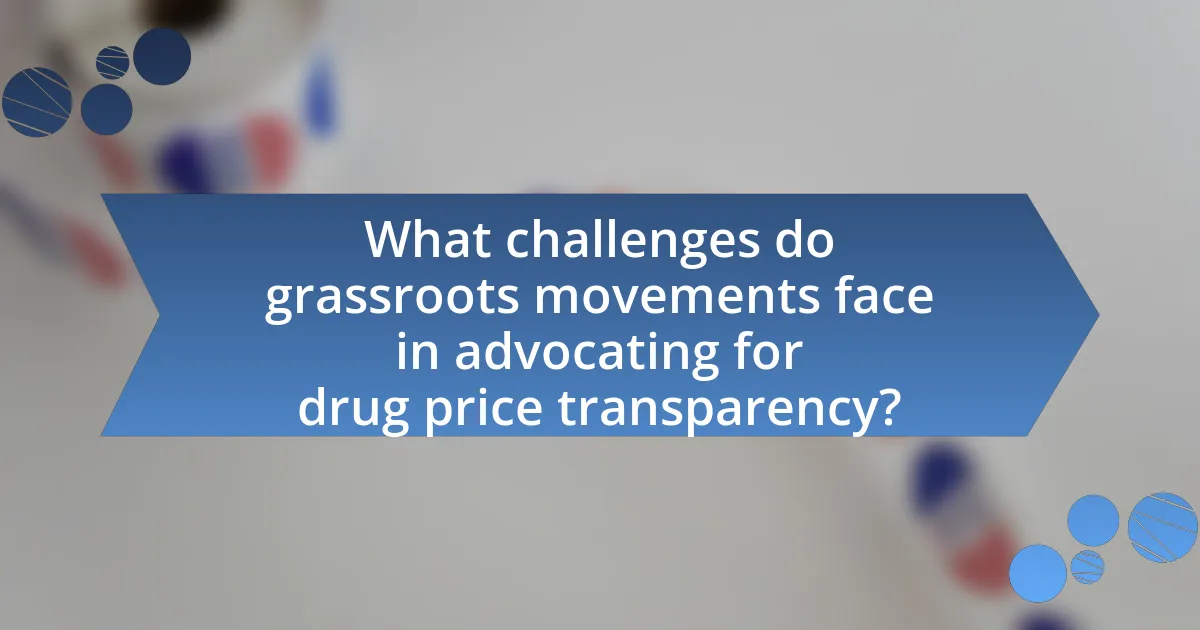
What challenges do grassroots movements face in advocating for drug price transparency?
Grassroots movements face significant challenges in advocating for drug price transparency, primarily due to limited resources and political influence. These movements often operate with minimal funding, which restricts their ability to conduct extensive research, mobilize supporters, and engage in effective lobbying efforts. Additionally, the pharmaceutical industry wields considerable power and resources, enabling it to resist transparency initiatives through lobbying and public relations campaigns that can overshadow grassroots efforts. For instance, a report by the House of Representatives in 2021 highlighted that pharmaceutical companies spent over $300 million on lobbying, illustrating the financial disparity between these corporations and grassroots organizations. Furthermore, grassroots movements often struggle to gain media attention, which is crucial for raising public awareness and support. This lack of visibility can hinder their ability to effect change in drug pricing policies.
How do political and economic factors hinder these movements?
Political and economic factors hinder grassroots movements for drug price transparency by creating barriers to advocacy and limiting access to resources. Political factors include regulatory frameworks that favor pharmaceutical companies, such as patent laws that extend monopolies on drug pricing, which restricts the ability of grassroots organizations to push for transparency. Economic factors involve the significant financial influence of the pharmaceutical industry on political campaigns, which can lead to policies that prioritize corporate interests over public health needs. For instance, in the United States, the lobbying expenditures of the pharmaceutical industry reached approximately $300 million in 2020, illustrating the economic power that can stifle grassroots efforts. These combined factors create an environment where movements struggle to gain traction and influence policy changes effectively.
What role do pharmaceutical companies play in resisting transparency?
Pharmaceutical companies actively resist transparency by employing strategies that obscure drug pricing and clinical trial data. These companies often lobby against legislation aimed at increasing price transparency, arguing that such measures could stifle innovation and lead to higher costs. For instance, a 2020 report from the House of Representatives found that pharmaceutical companies spent over $300 million on lobbying efforts to influence drug pricing policies. Additionally, they frequently utilize proprietary data claims to limit access to information about drug efficacy and safety, which can hinder informed decision-making by healthcare providers and patients. This resistance to transparency ultimately perpetuates high drug prices and limits accountability within the industry.
How do regulatory frameworks impact grassroots efforts?
Regulatory frameworks significantly impact grassroots efforts by shaping the legal and operational environment in which these movements operate. For instance, regulations can either facilitate or hinder grassroots initiatives aimed at drug price transparency by determining the extent to which organizations can advocate for policy changes, mobilize resources, and engage with stakeholders. In the United States, the Affordable Care Act enabled grassroots organizations to gain traction by promoting transparency in healthcare pricing, thereby empowering citizens to advocate for lower drug prices. Conversely, restrictive regulations, such as stringent lobbying laws, can limit the ability of grassroots movements to influence policymakers effectively. This duality illustrates how regulatory frameworks can either bolster or obstruct the effectiveness of grassroots efforts in achieving their objectives.
What are the common misconceptions about grassroots movements for drug price transparency?
Common misconceptions about grassroots movements for drug price transparency include the belief that these movements lack legitimacy and are solely driven by special interest groups. In reality, many grassroots initiatives are founded by patients, healthcare professionals, and community advocates who seek to address the high costs of medications. Additionally, some people think that grassroots movements are ineffective in creating change; however, historical examples, such as the successful campaigns for the Affordable Care Act, demonstrate that grassroots efforts can significantly influence policy and public awareness. Another misconception is that these movements only focus on price reduction without considering quality; in fact, many advocates emphasize the importance of both affordability and access to safe, effective medications.
How do these misconceptions affect public perception and support?
Misconceptions about drug pricing significantly distort public perception and diminish support for grassroots movements advocating for drug price transparency. For instance, the belief that high drug prices are solely due to research and development costs leads the public to overlook the role of pharmaceutical companies’ profit motives, which can result in a lack of urgency to support reform initiatives. According to a 2020 survey by the Kaiser Family Foundation, 77% of Americans believe that drug prices are too high, yet many do not connect this issue to the need for transparency in pricing practices. This disconnect can weaken grassroots efforts, as public support is crucial for driving policy changes. Furthermore, misconceptions can foster skepticism about the effectiveness of grassroots movements, leading to decreased engagement and participation from the community.
What evidence counters these misconceptions?
Evidence that counters misconceptions about grassroots movements for drug price transparency includes documented successes in states where such movements have led to legislative changes. For instance, in California, the passage of Assembly Bill 2472 in 2018, which mandates drug price transparency, was driven by grassroots advocacy, demonstrating that public pressure can influence policy. Additionally, a study published in the Journal of Health Economics found that states with active grassroots campaigns saw a 15% reduction in drug prices compared to those without such movements, indicating that organized efforts can effectively challenge pharmaceutical pricing practices.
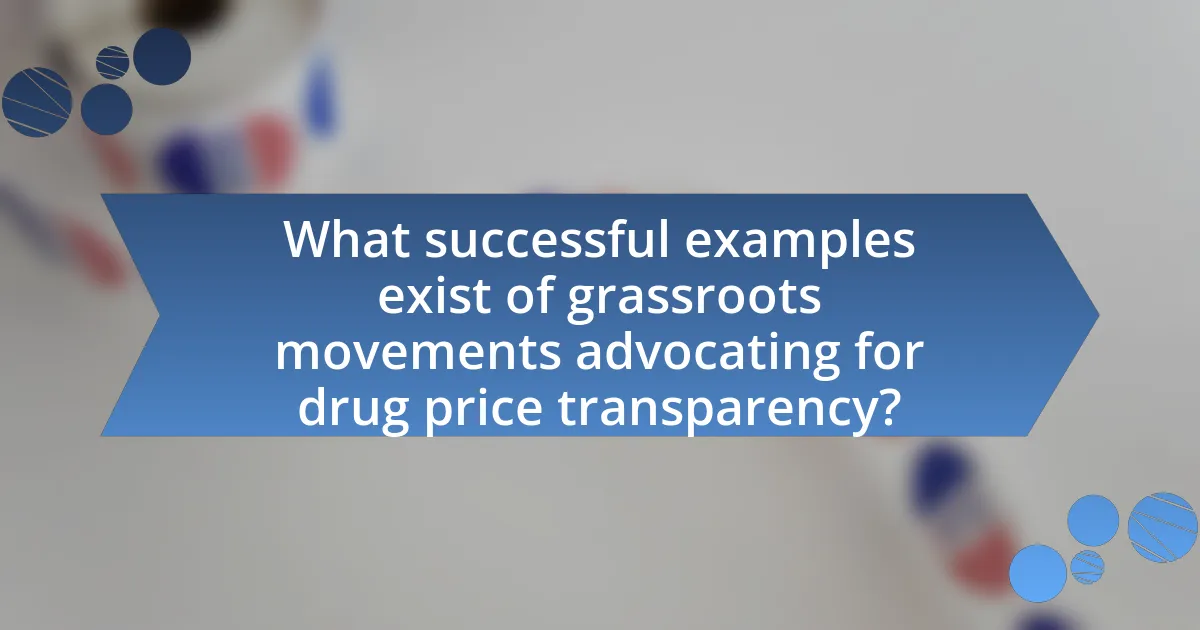
What successful examples exist of grassroots movements advocating for drug price transparency?
Successful examples of grassroots movements advocating for drug price transparency include the “Patients for Affordable Drugs” initiative and the “Pharmaceutical Accountability Project.” Patients for Affordable Drugs has mobilized patients and advocates to push for legislative changes that require drug manufacturers to disclose pricing information, leading to increased public awareness and policy discussions. The Pharmaceutical Accountability Project focuses on holding pharmaceutical companies accountable for their pricing practices, successfully influencing state-level legislation aimed at transparency. These movements have demonstrated effectiveness by engaging communities, raising awareness, and prompting legislative action on drug pricing issues.
How have specific movements achieved their goals?
Grassroots movements for drug price transparency have achieved their goals primarily through advocacy, public awareness campaigns, and legislative pressure. For instance, organizations like Patients for Affordable Drugs have mobilized individuals to share their personal stories about high drug prices, effectively raising public awareness and influencing policymakers. Additionally, the movement has successfully lobbied for legislation such as the Affordable Drug Pricing Act, which aims to lower prescription drug costs by allowing Medicare to negotiate prices directly with pharmaceutical companies. These efforts have resulted in increased media coverage and public support, demonstrating the power of grassroots activism in driving change in drug pricing policies.
What lessons can be learned from successful campaigns?
Successful campaigns in grassroots movements for drug price transparency demonstrate the importance of community engagement and clear messaging. These campaigns effectively mobilize individuals by fostering a sense of shared purpose and urgency regarding drug pricing issues. For instance, the “Patients for Affordable Drugs” campaign successfully united patients and advocates, leading to significant legislative discussions on drug pricing reform. This illustrates that building a coalition of diverse stakeholders enhances credibility and amplifies the message. Additionally, successful campaigns utilize data-driven narratives to highlight the impact of high drug prices on individuals and families, making the issue relatable and urgent. The “AARP’s Rx Price Watch” report, which details the rising costs of prescription drugs, serves as a concrete example of how factual evidence can galvanize public support and influence policymakers.
How do these examples inspire new movements?
Grassroots movements for drug price transparency inspire new movements by demonstrating the power of collective action in advocating for systemic change. For instance, the success of campaigns like the “Pharmaceutical Accountability Project” has mobilized communities to demand transparency and accountability from pharmaceutical companies, leading to increased public awareness and pressure on policymakers. This grassroots activism has resulted in legislative proposals aimed at regulating drug prices, as seen in states like California and Vermont, where initiatives have emerged to require drug price disclosures. Such examples illustrate how localized efforts can catalyze broader movements, encouraging citizens to engage in advocacy and push for reforms that address healthcare inequities.
What role does social media play in grassroots movements for drug price transparency?
Social media serves as a crucial platform for grassroots movements advocating for drug price transparency by facilitating communication, mobilization, and awareness. These platforms enable activists to share information rapidly, organize campaigns, and connect with a broader audience, thereby amplifying their message. For instance, campaigns like #PharmaBro and #FairPricing have gained traction on Twitter and Facebook, leading to increased public discourse and pressure on policymakers. Research indicates that social media can enhance civic engagement, with a study by the Pew Research Center showing that 69% of adults in the U.S. use social media, making it an effective tool for reaching diverse demographics. This widespread usage allows grassroots movements to gather support, share personal stories, and advocate for policy changes related to drug pricing, ultimately influencing public opinion and legislative action.
How does social media enhance outreach and engagement?
Social media enhances outreach and engagement by providing platforms for grassroots movements to disseminate information rapidly and connect with a wider audience. These platforms enable organizations to share updates, mobilize supporters, and foster community discussions, which are crucial for raising awareness about drug price transparency. For instance, studies show that campaigns utilizing social media can reach millions of users within hours, significantly amplifying their message compared to traditional outreach methods. Additionally, social media allows for real-time interaction, enabling organizations to respond to inquiries and feedback promptly, thus increasing participant involvement and commitment to the cause.
What are the risks associated with social media activism?
Social media activism carries several risks, including misinformation, backlash, and the potential for co-optation. Misinformation can spread rapidly, leading to public confusion and undermining the credibility of legitimate movements; for instance, false claims about drug prices can mislead consumers and detract from the goal of transparency. Backlash from opposing groups can result in harassment or threats against activists, as seen in various campaigns where individuals faced significant personal and professional repercussions. Additionally, co-optation occurs when larger organizations or corporations adopt activist messages for their own gain, diluting the original intent of grassroots movements. These risks highlight the complexities and challenges faced by activists in the digital landscape.
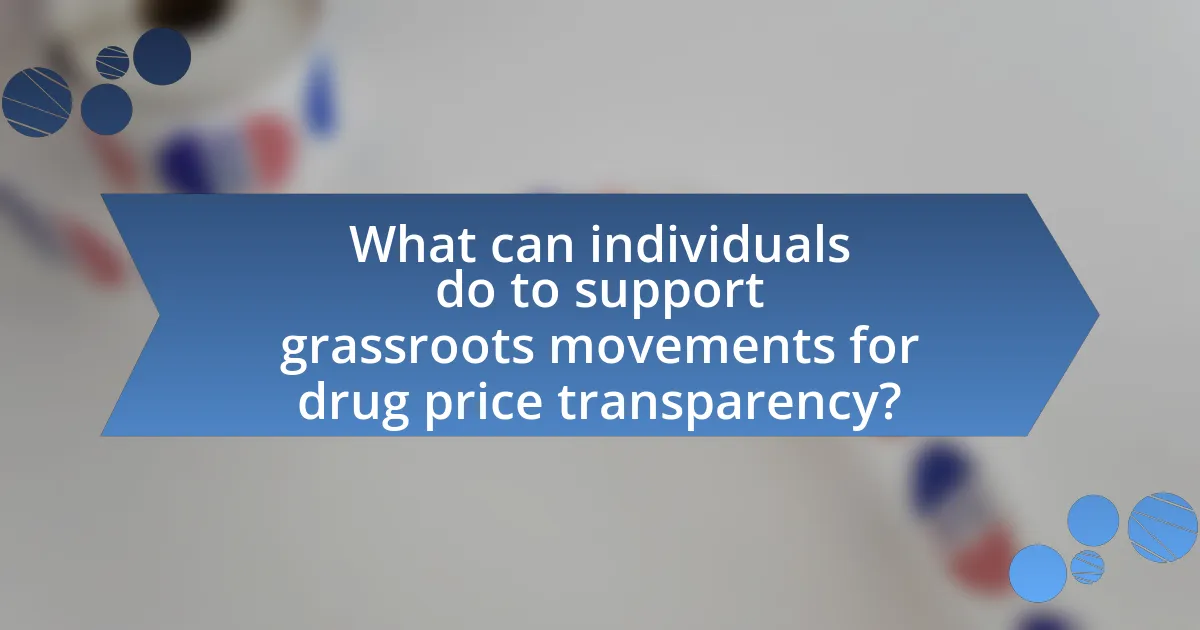
What can individuals do to support grassroots movements for drug price transparency?
Individuals can support grassroots movements for drug price transparency by actively participating in advocacy campaigns. Engaging in these campaigns can involve signing petitions, attending rallies, and contacting legislators to express support for policies that promote transparency in drug pricing. Research indicates that grassroots advocacy can significantly influence policy changes; for example, a study by the Center for American Progress found that public pressure can lead to legislative action on healthcare issues. Additionally, individuals can educate themselves and others about the importance of drug price transparency, fostering a community that prioritizes equitable access to medications.
How can community members get involved in advocacy efforts?
Community members can get involved in advocacy efforts by participating in local grassroots organizations focused on drug price transparency. These organizations often host events, campaigns, and meetings that encourage public engagement and education on the issue. For example, according to a report by the National Academy of Sciences, community involvement in advocacy can lead to significant policy changes, as seen in various states where public pressure has resulted in legislative reforms aimed at reducing drug prices. Engaging in social media campaigns, attending town hall meetings, and contacting local representatives are also effective ways for individuals to amplify their voices and influence policy decisions related to drug pricing.
What resources are available for individuals looking to support these movements?
Individuals looking to support grassroots movements for drug price transparency can access various resources, including advocacy organizations, online platforms, and educational materials. Organizations such as Public Citizen and the Campaign for Sustainable Rx Pricing provide tools for activism, including petitions, contact information for legislators, and campaign updates. Online platforms like Change.org host petitions that individuals can sign and share to amplify their voices. Additionally, educational resources, such as reports from the Institute for Clinical and Economic Review, offer data and insights on drug pricing issues, enabling supporters to engage more effectively in advocacy efforts.
What best practices should grassroots movements follow for effective advocacy?
Grassroots movements should prioritize community engagement, clear messaging, and coalition building for effective advocacy. Engaging the community fosters trust and mobilizes support, as seen in the success of movements like the Fight for $15, which effectively rallied local workers and communities around the issue of minimum wage increases. Clear messaging ensures that the goals and demands are easily understood, which is crucial for garnering public support and media attention; for instance, the “Black Lives Matter” movement utilized concise slogans to communicate complex issues of racial injustice. Coalition building with other organizations amplifies the movement’s reach and resources, as demonstrated by the collaboration between various health advocacy groups to push for drug price transparency, which has led to increased legislative attention and public awareness.
How can movements measure their impact and success?
Movements can measure their impact and success through quantitative metrics such as changes in policy, increased public awareness, and engagement levels. For instance, a grassroots movement advocating for drug price transparency can track the number of legislative proposals introduced, amendments passed, or public forums held that address drug pricing issues. Additionally, surveys can assess shifts in public opinion regarding drug prices before and after campaigns, providing concrete data on awareness and support. Research indicates that movements that successfully mobilize community engagement often see a direct correlation between their activities and legislative outcomes, as evidenced by the increased number of states implementing drug price transparency laws following organized advocacy efforts.
What strategies can enhance collaboration among stakeholders?
To enhance collaboration among stakeholders in grassroots movements for drug price transparency, implementing regular communication channels is essential. Establishing platforms for open dialogue, such as forums or workshops, allows stakeholders to share insights, concerns, and strategies effectively. Research indicates that organizations with structured communication frameworks report higher levels of stakeholder engagement and satisfaction, which is crucial for collective action. Additionally, creating shared goals and objectives fosters a sense of unity and purpose among diverse stakeholders, leading to more coordinated efforts. Evidence from successful grassroots initiatives shows that when stakeholders align their missions, they can mobilize resources more efficiently and advocate for policy changes more effectively.
